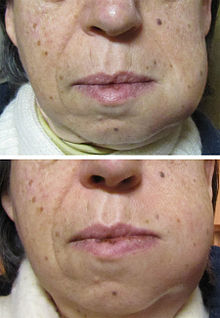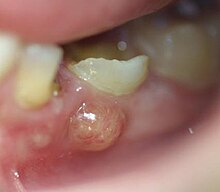Odontogenic infection
| Classification according to ICD-10 | |
|---|---|
| K04.4 | Acute apical periodontitis of pulpal origin |
| K04.5 | Chronic apical periodontal disease |
| K04.6 | Periapical abscess with fistula |
| K04.7 | Periapical abscess without a fistula |
| K05.2 | Acute periodontal disease |
| K05.3 | Chronic periodontal disease |
| K10.2 | Inflammatory conditions of the jaws |
| K10.3 | Alveolitis of the jaw |
| K10.8 | Other specified diseases of the jaw |
| K10.9 | Disease of the jaw, unspecified |
| K12.2 | Phlegmon and abscess of the mouth |
| J01 | Acute sinusitis |
| J01.0 | Acute maxillary sinusitis |
| J39.0 | Retropharyngeal abscess and parapharyngeal abscess |
| A42.2 | Cervicofacial actinomycosis |
| ICD-10 online (WHO version 2019) | |
The generic term odontogenic infections is understood to mean inflammation that originates from a tooth or from the periodontium (periodontium) and can develop into a jaw abscess or periodontal abscess, sometimes with cheek edema.
The adjective odontogenic means “starting from the tooth” ( Greek : ὀδούς odous “the tooth” and γὲνεσις genesis “origin”).
causes

The most common cause of an odontogenic infection is the deep carious tooth, in which pathogenic germs have infected the pulp . This leads to pulpitis and, in the further untreated course, to devitalization (death) of the tooth. As a result, periapical inflammation, apical periodontitis , can develop, which is an inflammation in the tip of the tooth of a tooth. This can be limited to the respective region, but in rare cases it can spread further by lymphogenic or hematogenic routes.
The second most common causes of odontogenic infection are periodontal in origin ( marginal periodontitis ). This can develop into gingivitis , a gingival abscess , a periodontal abscess, or a pericoronal abscess.
Causative germs
Odontogenic infections are almost always polymicrobial infections caused by anaerobic and aerobic germs. Mostly you will find Peptostreptococci , Streptococcus mutans , Capnocytophaga gingivalis , Eikenella corrodens , Staphylococcus aureus , Bacteroides TYPES (especially Bacteroides forsythus ), Prevotella intermedia , Fusobacterium nucleatum , Actinobazillen , actinomycetes Borrelia , Veillonella parvula , Porphyromonas gingivalis , Campylobacter rectus , and others. The accompanying flora allows conclusions to be drawn about odontogenic infections in the case of systemic diseases .
Diagnosis and symptoms
Odontogenic infections are painful in the acute state. If a tooth is the cause, it often reacts with tapping pain, with increasing pain in the lying position of the patient, with increased pain when the patient is warm and pain relief when it is cold. The tooth in question may be loosened and elongated . The inflammation can lead to a parulis ("big cheek") and lymphadenitis as well as an acute purulent sialadenitis . The affected lymph nodes - mostly submandibular - are swollen and tend to be tender. Radiologically, osteolytic processes, periodontal bone loss, periapical translucency and / or an enlargement of the periodontal gap can be diagnosed.
Complications
If the odontogenic inflammation progresses, the osteomyelitis can develop into an abscess , an encapsulated collection of pus caused by inflammatory tissue melting. Due to the resulting pressure, the pus (pus) seeks out a way to relieve pressure . This in turn creates a painful tension of the relatively resistant periosteum before the pus breaks through the periosteum and the surrounding soft tissue in a fistulous manner.
From this, the purulent odontogenic inflammation can develop phlegmonously , for example with the development of floor phlegmon , which, if spread cranially , can develop into meningitis or a brain abscess , both of which can be life-threatening. Periapical ostitis or periodontal infection of the upper molars can develop into odontogenic sinusitis (inflammation of the maxillary sinus), which accounts for around 20% of all sinusitis. In the case of maxillary sinusitis (affecting the midface and lower jaw) , the inflammatory exudate breaks through the floor of the maxillary sinus into the maxillary sinus. From there, the inflammation can spread to other paranasal sinuses ( frontal sinuses , ethmoid cells , sphenoid sinus ).
If it spreads caudally , mediastinitis can result . Patients with heart valve defects and artificial heart valves or a status after rheumatic or bacterial endocarditis are at risk . As a rule, however, such infections remain localized.
Extensive osteomyelitis can also develop from odontogenic inflammation . The inflammation can destroy small vessels and the trophics of the bone. A sequester is possible. The x-ray shows cloudy, blurred osteolyses and sclerosing changes while the bone structure is still partially preserved.
If the area around the inferior alveolar nerve is involved, paresthesia can occur ( Vincent symptom ).
If there is haematogenic spread, there is also a risk of periprosthetic infection in patients with joint endoprostheses .
therapy
On the one hand, attempts are made to treat the cause, which means endodontic treatment in the case of infection originating from a tooth . First, access to the root canal system is created (trepanation). The canals are then conically widened (“prepared”) with hand files or machine-driven rotating instruments . On the one hand, this removes necrotic pulp tissue and at the same time creates an outflow through which pus and gases can escape. The root canal is then rinsed.
On the other hand, the abscess is opened broadly under local anesthesia through an incision to allow the pus to drain further ( Ubi pus ibi evacua - “Where there is pus, empty it there”, Hippocrates of Kos). Then a drainage in the form of a gauze strip is inserted for one to two days . A stab incision is not enough to create sufficient drainage. The incision also requires cutting the periosteum. The latter can be painful despite local anesthesia, because the local anesthesia only has a limited effect in the inflamed area (acidic environment).
If the cause is periodontal, the gingival pockets are cleaned, possibly including debridement , also followed by an opening of the abscess. If the periodontal inflammation has spread to the pulp, endodontic treatment of the tooth follows.
Further therapeutic measures, such as an extraction of the tooth, a root tip resection or periodontal surgical measures are only carried out after the acute inflammation has subsided.
As a rule, no antibiotics are given, except for the risk patients mentioned . Antibiotic shielding by means of a β-lactam antibiotic is indicated for high- risk patients . In the case of extensive odontogenic infections with a tendency to spread, simultaneous antibiotic therapy is recommended. The spectrum of germs is covered by modern broad spectrum antibiotics such as amoxicillin , cephalosporins or clindamycin .
Also anti-inflammatory drugs are not usually displayed. The accompanying edema disappears quickly after the cause has been eliminated. Cool compresses can accelerate the swelling.
Differential diagnosis
In terms of differential diagnosis , superinfected cysts and tumors , in particular by means of X-ray diagnosis, can be excluded.
literature
- Marianne Abele-Horn: Antimicrobial Therapy. Decision support for the treatment and prophylaxis of infectious diseases. With the collaboration of Werner Heinz, Hartwig Klinker, Johann Schurz and August Stich, 2nd, revised and expanded edition. Peter Wiehl, Marburg 2009, ISBN 978-3-927219-14-4 , p. 108 f. ( Odontogenic infections ).
Individual evidence
- ↑ K. Miksits, H. Hahn: Basic knowledge Medical Microbiology. 3. Edition. Springer Verlag, 2004, ISBN 3-540-01525-6 ( Google Books )
- ↑ Odontogenic infections ( Memento of the original from December 15, 2013 in the Internet Archive ) Info: The archive link was inserted automatically and has not yet been checked. Please check the original and archive link according to the instructions and then remove this notice. , Infection network
- ↑ Odontogenic infections and abscesses ( Memento of the original from May 24, 2012 in the Internet Archive ) Info: The archive link was inserted automatically and has not yet been checked. Please check the original and archive link according to the instructions and then remove this notice. (PDF; 273 kB) AWMF guidelines (in revision)
- ↑ a b H. Scheunemann: Odontogenic purulent infections: diagnosis and therapy. In: Dtsch Arztebl. 1986; 83 (50), pp. A-3542.
- ↑ W. Kirch: Endocarditis prophylaxis and dental foci as causes of fever of unknown origin. In: Dental communications. Volume 76, Number 3, February 1986, pp. 228-230, 233, ISSN 0044-1643 . PMID 3459316 .
- ↑ W. Kirch, EM Kasperk u. a .: Various clinical manifestations with a dentogenic cause. In: Medical Clinic (Munich, Germany: 1983). Volume 83, Number 23, November 1988, pp. 790-794, ISSN 0723-5003 . PMID 3211068 .
- ↑ a b M. Thoma: Odontogenic infections. (PDF; 41 kB) In: Bayerisches Zahnärztblatt. 4/2010, p. 66.
- ↑ Michael Hülsmann: Endodontics. In: RW Ott, H.-P. Vollmer, WE Krug (ed.): Clinic and practice guide dentistry. Georg Thieme Verlag, Stuttgart / New York 2003, ISBN 3-13-131781-7 .


